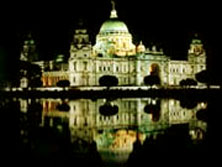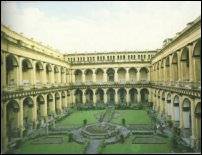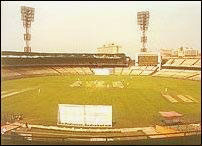|
|
|
PLACES OF INTEREST
|
 |
A splendid architectural structure in white marble, modeled on the Taj Mahal,
was built in the early 20th century. In memory of Queen Victoria and was
formally inaugurated by the Prince of Wales in 1921 who later became King Edward
VIII of England. The stately bronze statue of the queen near the entrance, the
brass canons, wrought iron street lamps, manicured lawns, gardens and pathways,
the magical lighting effect in the evening and a fairy tale 'Fountain of Joy'
facing the memorial building create an atmosphere of unforgettable charm.
 |
This museum was established in 1878 on Jawaharlal Nehru Road. The museum is built in Italian architectural style and is considered as the largest museum in the country and one of the best in Asia. The largest museum in the country, the museum has six sections: Art, Archaeology, Anthropology, Geology, Zoology and Industry (economic botany). From the Egyptian mummy to the skeleton of the whale and some rare statues; the museum has every thing. One of the rooms has a collection of meteorites. The museum also has a unique fossil collection of prehistoric animals which includes a giant crocodile and a huge tortoise. The art collection has many fine pieces from Orissa and other temples and superb example of Buddhist Gandharan art.
 |
In the
North-West corner of the Maidan are small & pleasantly laid out Eden
Gardens. The gardens were created in 1840 and
named after the sister of Lord Auckland, the former governor general. The idea
was to make a Biblical - style garden of Eden in India. The expanse dotted with
beautiful trees and shrubs is intersected by winding paths, and there is a large
artificial lake. Alongside the gardens, is the world famous Eden Gardens cricket
stadium. The stadium is supposed to be the largest in Asia with a seating
capacity of more than a lakh spectators. The Kolkata cricket ground, where
International test & one day matches are held, is also with in the gardens.
Near the gardens you can take a pleasant walk along the bank of hoogly river.
After the events of 1756, the British decided
there would be no repetition of the attack on the city and set out to replace
the original Fort William, in the Maidan , with a massive and impregnable new
fort. First they cleared out the inhabitants of the village of Govindpur and in
1758 laid the foundations of a fort. Around the fort a huge expanse of jungle
was cut down to give the cannons a clear line of fire but, as usually happens,
the fort has never fired a shot in anger.
The fort is still in use today and visitors are only allowed
inside with special permission. Even the trenches and deep fortifications
surrounding the fort's massive walls seem to be out of bounds.
The area cleared around Fort William became the Maidan, the
'lungs' of modern Kolkata. This huge green expanse stretches three km north to
south and is over a km wide. It is bound by Strand Rd along the river to the
west and by Chowringhee Rd, lined with shops, offices, hotels and eating places,
to the east. The stream known as Tolly's Nullah forms its southern boundary, and
here you will find a racecourse and the Victoria Memorial. In the north-west
corner of the Maidan is Eden Gardens, while Raj Bhavan overlooks it from the
north.
Now officially renamed the Shahid Minar,
this 48m column tower over the northern end of the Maidan. It was erected in
1828 and named after Sir David Ochterlony, who is credited with winning the
Nepal War. The column is an intriguing combination of Turkish, Egyptian
and Syrian architectural elements.
There's a fine view from the top of the column, but
permission to ascend must be obtained from police headquarters, which is on Lal
Bazaar St. It's only open Monday to Friday and you should simply ask for a
'monument pass' at the Assistant Commissioner's office on the 2nd floor.
Built between 1839 and 1847, St Paul's Cathedral is one of India's most important churches. It's east of the Victoria Memorial at the South end of the Maidan. The steeple fell during an earthquake in 1897 and was redesigned and rebuilt. Inside there's some interesting memorials and stained glass, including the west window by Sir Edward Burne-Jones. It's open to visitors from 9 am to noon, and from 3 to 6 pm. Sunday services are at 7.30 and 8.30 am, and 6 pm.
|
Sightseeing in West Bengal |
|
Victoria Memorial ¦¦ India Museum ¦¦ Eden Gardens ¦¦ St. Paul Cathedral ¦¦ Tiger Hill ¦¦ Senchal Lake ¦¦ Kanchenjunga ¦¦ Dhirdham Temple ¦¦ Gymkhana Club ¦¦ Llyod Botanical Gardens ¦¦ Gompas ¦¦ Flower Nurseries ¦¦ Nature Interpretation Centre |
|
General Info ¦¦ Trekking ¦¦ Sports ¦¦ Museums ¦¦ Personalities ¦¦ Dances |
|
Wildlife ¦¦ Map ¦¦ Beaches ¦¦ Festivals ¦¦ Regional Highlight ¦¦ Cities |
| |||||||||||||||||